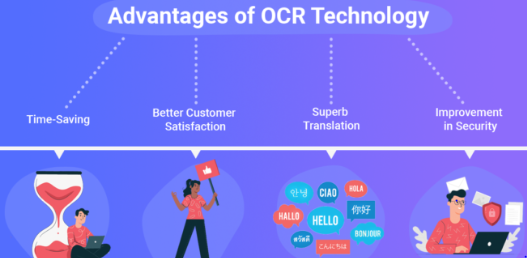It is an intriguing business strategy that can support company growth and improve customer service. The Advantages and Industrial Use Cases of OCR enables businesses to quickly and accurately use the collected data more wisely. In 2020, the market for optical character recognition was estimated to be worth USD 7.46 billion. From 2021 to 2028, it is anticipated to rise at a compound annual growth rate (CAGR) of 16.7%. OCR technology, abbreviated for Optical character recognition, enables the identification of unique characters, letters, and alphabets through an optical device. Businesses in every industry are vulnerable to threats such as identity theft, ransomware, and data breaches. Given the accelerating number of financial crimes, most institutions opt for robust identity verification solutions with OCR technology to weed out false documents and onboard legitimate customers.
OCR technology gained prominence back in the early 1990s when it digitized newspapers. It then went through various transitional stages to become the go-to automation system for extracting data from documents, whether they are provided in written or printed form. Thanks to continuous technological advancements, OCR technology has now matured enough to reach a remarkable accuracy rate of no less than 90%.
The readability of digital documents is made possible through modern OCR software as they extract data from a wide array of paper-based documents such as bank invoices, corporate contracts, identity documents, bank statements, billing receipts, etc., and convert it into a machine-readable format. Once this has been done, digital files then become searchable, viewable, and editable. Advantages and Industrial Use Cases of OCR are mentioned in this post.
Listing Down the Benefits of OCR Technology
Listed below are 8 major advantages of using OCR software in your business:
1. Elimination of Traditional Identification
Companies today have to identify every customer that is onboarded due to increasing instances of fraud, especially in financial institutions. With the help of OCR technology, firms can make things more convenient by automatically extracting the identity details from the documents provided.
2. Cost Reduction
Automated data extraction and document verification processes substantially reduce manual labor. This saves the company’s resources that were previously being spent on hiring skilled employees for the same purpose.
3. A Better Alternative for Manual Data Entry Operations
Business operations, which typically include manual data entry processes, can be streamlined through OCR technology. Within seconds, an OCR system can collect data from ID documents, making it readily available for verification to be completed.
4. Boost the Business Workflow
As OCR technology enables automated data extraction and processing, it allows businesses to speed up their day-to-day operations which ultimately gives a rise to the company’s revenue.
5. Minimizes Error
Companies can easily reduce errors that may have occurred through manual data entry processes. AI-based optical character recognition systems extract the customer’s information while mitigating faults and errors.
6. Enhanced Productivity
A robust data collection process enabled by OCR technology enhances productivity within a business through a better allocation of resources.
7. Automated Content Processing
OCR technology allows identity verification software to extract information from ID documents that are displayed on a computer screen. For instance, when customers show a government-issued ID card in their webcam to get verified remotely, OCR technology extracts information such as their full name, card number, address, date of birth, etc., and adds it into respective fields.
8. Online Identity Verification
Online businesses that aim to achieve high levels of security and a fraud-free customer base perform identity verification through their online platforms. This also helps them stay compliant with global regulatory obligations, such as the ones issued by the FATF (Financial Action Task Force), and the IMF (International Monetary Fund).
Digital document authentication through official ID documents helps online enterprises in filtering out fraudulent individuals. Within this process, OCR technology is used for extracting data from the documents provided by the customer.
Advantages and Industrial Use Cases of OCR Technology
1. Financial Institutions
Financial institutions, such as banks, insurance companies, brokerage firms, fintechs, and stock exchanges have long been utilizing OCR technology to complete manual data entry processes without manual efforts. An image of a bank statement is captured by a smartphone, handwritten characters and printed text is scanned rapidly, and the document is analyzed for further processes. Other applications of OCR technology include data extraction from financial statements, bank checks, printed bank statements, applications for loans, and other paper-based documents.
2. The Legal Sector
The legal sector requires heaps of paper-based files and reports to be processed before and after proceedings. To reduce the time spent on manual data collection and reduce storage space for piled-up reports, OCR technology can digitally store paper-based documents through a single scan, making them editable.
Other Industries
Optical character recognition is normally used in numerous other business sectors, a few of which are listed below:
- Educational institutions
- Investment firms
- Retail stores
- E-commerce websites and online platforms
- Online casinos
- Law enforcement agencies
- Corporate offices
Summing it Up
The conversion of paper-based scanned or printed documents into a machine-readable digital format is one task that is common to most businesses. Before the introduction of OCR technology, companies had only one option – re-write or type document texts manually. This method soon became insufficient, particularly as it was time-consuming, inconvenient, inefficient, and prone to human errors. Fortunately, labor-intensive tasks have now been substituted by AI-backed OCR technology systems. Handwritten and printed documents are now easy to search, view online, or even edit.
Optical character recognition is employed for a variety of functions in the business world throughout the article. The process’s capacity to extract information from a mass of unstructured data is the benefit across all of these scenarios. This characteristic is crucial because the interchange of data is a fundamental tenet of many institutions.
Integrating technology like OCR not only helps the business innovate but also gives the staff a chance to develop and use superior technologies. Benefits range from faster speed, more accessibility, increased productivity, and even improved customer happiness.

